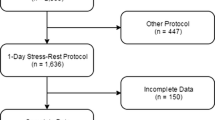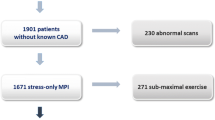Abstract.
We determined the incidence of delayed 24-h reversibility post thallium-201 reinjection and imaging at 4 h, as well as the prognostic and significance of such delayed reversibility. We studied 46 consecutive patients with persistent thallium-201 perfusion or incompletely reversible single-photon emission tomography (SPET) perfusion defects acquired within 10 min after reinjection performed 4 h after stress. In 38 of 46 patients (82%) 24-h images showed no further reversibility beyond the post-reinjection 4-h study (group A). Eight of 46 patients (17%) demonstrated reversibility on 24-h imaging (group B). Of these eight, three patients showed no improvement compared with the post-stress images, with a mean perfusion score of the abnormal segments of 1.25±0.50 on the 4-h images, and of 3.00 on the 24-h images, where normal is 4. Four patients presented with nine mixed regions. Four of these regions showed an improvement in the mean perfusion score of 2.50±0.58 on 4- and 24-h images. Two of them, with moderate/severe defects, demonstrated complete reversibility at 4-h post-reinjection imaging. In addition, five other regions presented no improvement at 4-h imaging, but showed an improvement in the mean perfusion score from 0.80±0.84 at 4-h to 3.30±0.89 at 24-h imaging. Two of these regions in one patient showed a severe perfusion score of 0 at 4 h, and complete reversibility at 24 hours, with a mean score improvement of 4. Another patient had three severe perfusion defects; two of them redistributed partially at 4 h and completely at 24 h. The remaining segment with a perfusion score of 0 at 4 h, presented complete reversibility with a score of 4 at 24 h. Two (4%) patients revealed significant reversibility at 24 h in a region that was severely underperfused after post-reinjection imaging at 4 h. Among group B patients, 75% (6/8) had recent acute ischemic syndrome, compared with only 13% (5/38) in group A (P = 0.001). Among 11 patients with unstable angina, six (55%) had evidence of delayed 24-h reversibility, compared with 2 of 35 (6%) patients without clinically acute ischemia (P = 0.001). On follow-up, there were seven (17%) cardiac deaths among the 38 group A patients but three (38%) among the eight group B patients (P = 0.3). These findings suggest that although the presence of delayed 24-h 201Tl, post-reinjection reversibility is infrequent, it has potential clinical importance. Thus, delayed 24-h imaging should be considered in the context of unstable angina or other acute coronary syndromes.
Similar content being viewed by others
Author information
Authors and Affiliations
Additional information
Received 17 November 1997 and in revised form 17 January 1998
Rights and permissions
About this article
Cite this article
Bobba, K., Botvinick, E., Sciammarella, M. et al. Is there any advantage to the acquisition of 24-hour thallium images, in the presence of persistent perfusion defects at 4 h after reinjection?. Eur J Nucl Med 25, 509–514 (1998). https://doi.org/10.1007/s002590050251
Issue Date:
DOI: https://doi.org/10.1007/s002590050251




